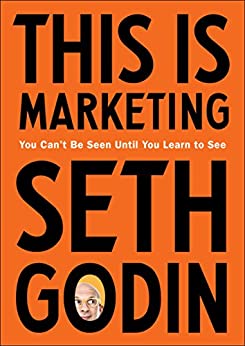This is Marketing
You Can't Be Seen Until You Learn to See


Forbes.com has eulogised Godin “[Godin] is a demigod on the Web, a best-selling author, highly sought-after lecturer, successful entrepreneur, respected pundit and high-profile blogger. He is uniquely respected for his understanding of the Internet.” More prosaically, he cut his teeth in the publishing industry and was early into the online world, with Yoyodyne, a direct marketing company, which was acquired by Yahoo. More recently Godin has become known for his curation and championing of new ideas and his seths.blog, principally around marketing and behaviour. He was inducted into the American Marketing Association’s Marketing Hall of Fame in 2018.
The world has evidently shifted from one of mass market – where we all watch the same shows on a handful of TV channels, for example – to a more individualised and empathetic one. One that relies on customised service and innovation – in TV-terms, we now watch what we select à la carte, from an infinite menu, when we want. The challenge for marketers is how to get people to notice your product in a very crowded and noisy market. Godin’s starting point is that the internet is not designed for marketing (like radio and TV were) – and while SEO consultants, Facebook experts and PR professionals may tell you otherwise, infact the internet is not somewhere everyone can find you if you shout in the right way, but “a billion tiny whispers, an endless series of selfish conversations that reely include you….“
The effective kind of marketing is – and always has been – about understanding your customers desires and needs. People don’t make a key and then look for a lock; likewise we shouldn’t make a product and then look for a market, it should always be the other way around. Find the need, create the product.
Godin sets out five marketing steps:
Riffing on Drucker, Godin says “culture beats strategy, so much that culture is strategy…. if you want to make change, begin by making culture. Begin by organizing a tightly knit group. Begin by getting people in sync.” You cannot change everyone, so ask “who’s it for?” and focus on them. We all believe in the stories we tell ourselves – and so what we say is not nearly as important as what others say about us, when it comes to marketing something.
Godin warns against being ‘marketing-driven’ in favour of being ‘market-driven’; don’t focus on the marketing fads and tricks, but on what people want. Marketing is about creating change, but he points out, you cannot change everyone, so identify who you can change. “You need to change someone. Or perhaps a group of someones.” So you need to identify who those someones are. Do they share a belief? A Geography? A Psychographic? Who will be your true fans? Who can share your ‘worldview‘ or rather, whose worldview can you serve?
For Godin ‘mass’ is boring, it is average. Specific is brave, it is accountable – so focus on the smallest viable audience, and from there growth will start.
Your best customers become your best salespeople. Few products become miracles of desire, so seek a path not a miracle. Who will miss it if its gone? Who are the true fans? Every long tail has a short head – someone is going to be a huge success, but its probably not going to be you, he reminds us.
Having found your tribe you need to lead it – but not fall into the trap of thinking you own it. You may share their worldview, but you don’t get to tell them what to do. If you are fortunate they will listen to you. They will most likely survive if you weren’t there, but your task is to get them to miss you if you did.
Godin recounts Harvard professor Marshall Ganz’s three-step narrative for action:
This book is written in short, staccato phrases that are easy to digest – as the above has been written, but lack a certain flow. It is the book of a podcaster perhaps? Nonetheless, the content is well observed and highly valuable, and easily consumed. It could probably have been written in a sentence: “don’t try to market to everyone, but identify the small band of true fans to build your sales and get them to spread the word”.
Title: This is Marketing: You Cant Be Seen Until You Learn to See
Author/s Name/s: Seth Godin
Publisher: Penguin Random House
ISBN: 978-0-241-37015-5
Publishing Date: November, 2018
Number of Pages: 260
Author Knowledge Rating: 1-5 (based on their years of experience, academic expertise in subject areas, and exposure to cross-functional thinking in the area)





















































Readability: 1-5 score(1=dense and v academic; 5=frantic; page turner)



























































Appropriate Length: (1=could have been written in 25% of the length;5=could have been longer)



























































Core Idea Value: (1=nonsense (or entirely esoteric); 5=game-changer)


































































